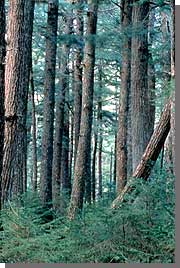 Nature reserves are areas selected to preserve and protect, in perpetuity, representative (typical) and special natural ecosystems, plant and animal species, features and natural processes. Scientific research and education are the primary uses of nature reserves and recreation is generally restricted.
Nature reserves are areas selected to preserve and protect, in perpetuity, representative (typical) and special natural ecosystems, plant and animal species, features and natural processes. Scientific research and education are the primary uses of nature reserves and recreation is generally restricted.
Nature Reserves are established to:
- provide areas suitable for scientific research and education;
- protect representative examples of natural ecosystems;
- provide examples of ecosystems that have been modified by humans and offer an opportunity to study the natural recovery of ecosystems from modification;
- protect rare or endangered native plants or animals in their natural habitats; and
- provide educational or research field areas for the long-term study of natural changes and balancing forces in undisturbed ecosystems.
Nature Reserves are protected under the Special Places Protection Act.
Information on other nature reserves is available here.
History
The first ecological (or nature) reserves grew out of efforts associated with the International Biological Program (IBP), conducted in 58 countries from 1964 to 1974. These efforts aimed to identify and preserve representative examples of the world's ecosystems for present and future biological research and education, for preservation of species, their genes, and habitats, and as benchmarks for comparison with ecosystems managed by humans (Peterson, 1974).
In Nova Scotia, the IBP research team identified sixty-nine sites, consisting primarily of fragile, relatively undisturbed ecosystems such as relict old-growth forest, sand dunes, river floodplains, coastal islands, lakeshores, and estuaries. The final report called for ecological reserves legislation to be enacted by each province (IBP-CT, 1974).
In 1981, the province proclaimed the Special Places Protection Act, which provided for the designation of "ecological sites". The Special Places Program was assigned to the Department of Education (Nova Scotia Museum), and over the period 1981-1994, additional sites of ecological significance were identified and seven ecological sites (known as "nature reserves") were designated under the Act, including two on private lands, with landowner permission.
In 1994, responsibility for protected areas, including nature reserves, was transferred to the Department of Natural Resources (DNR). Work continued towards the identification of new sites of ecological significance and the designation of additional nature reserves, and in 1998, responsibility for protected areas moved to the Department of the Environment.
Nature Reserves: Frequently Asked Questions
References:
Canadian Committee for the International Biological Programme - Conservation of Terrestrial Communities Subcommittee (IBP-CT). 1974. Ecological Reserves in the Maritimes - Terminal Report of the Scientific Advisory Panel, Region 7: Nova Scotia, New Brunswick, Prince Edward Island.
Peterson, E.B. 1974. A National System of Ecological Reserves for Canada. Report prepared under contract from the Canadian Committee for the International Biological Programme - Conservation of Terrestrial Communities Subcommittee (IBP-CT). Western Ecological Services, Edmonton, AB.

